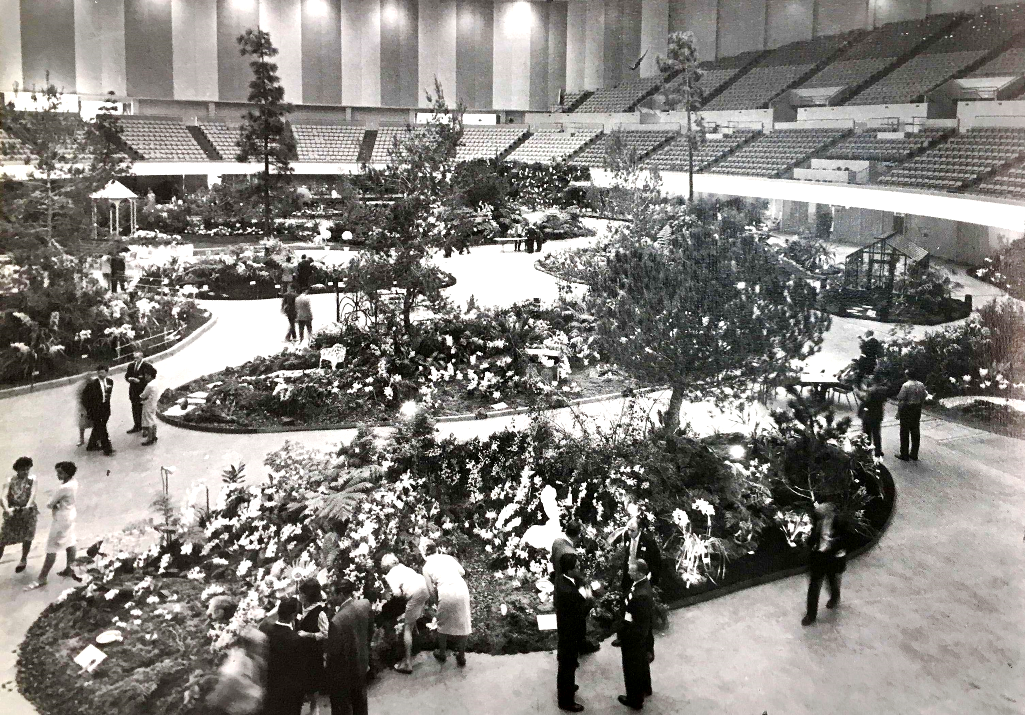February, 2019


A Blast from the Past: 1966 —
Fifth World Orchid Conference, in Long Beach!
Have there ever been, or will there ever be, as many orchids in Long Beach as there were in April, 1966? Luckily for us,
our President at that time was Lloyd R. De Garmo, highly qualified to edit the fat volume of Proceedings of the conference, and get them
published by the end of the year. There was also some excellent press coverage. But a couple of pictures reveal the scope
of the event, organized largely by the Orchid Society of Southern California and our own society, running from April 14 to April 17, 1966 at the
Long Beach Arena. The entire floor of the arena was filled with elaborate exhibits, viewed with enthusiasm by well-dressed
crowds.
Off camera, there were important seminars. It was a significant time in the history of the orchid business. Mericloning had only recently been applied successfully by orchid nurseries (the first one out of the gate was Vacherot et Lecoufle, in France). New developments in biology and technology were just beginning to be applied to orchids. Some of the presenters went on to distinguished careers in orchid biology, among them our friend Dr. Harold Koopowitz.
The plants, too, were undergoing rapid development. Many of the familiar names in orchid hybridization had their nurseries (or in some cases their personal greenhouses) in Southern California. Our members bought seedlings of the latest hybrids from these growers for as little as $2.50 (we know this from their advertisements in the SCOS newsletter), and sometimes grew them into fabulous specimen plants.
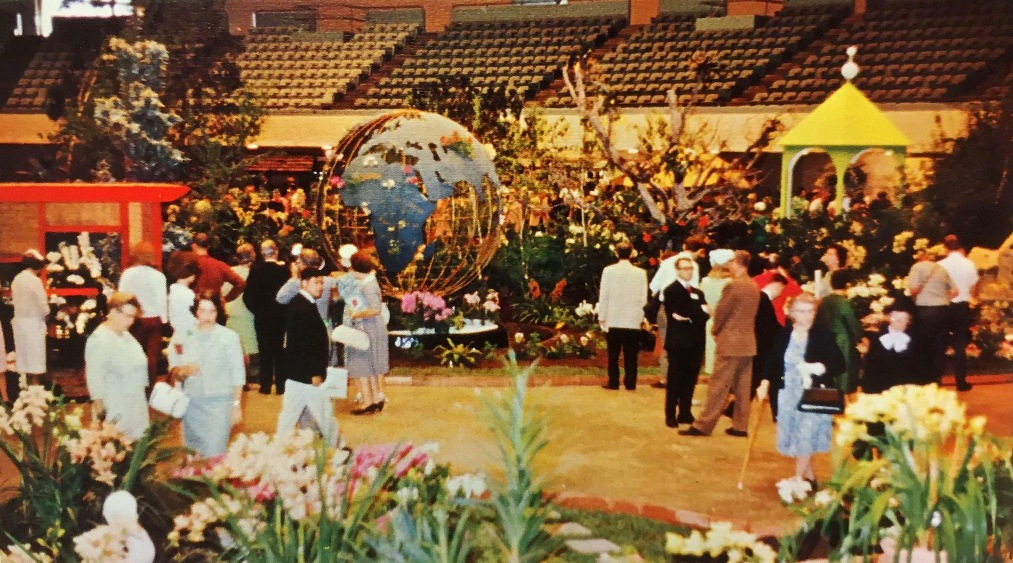
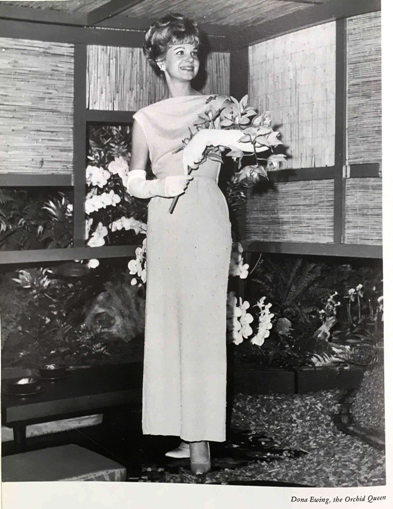
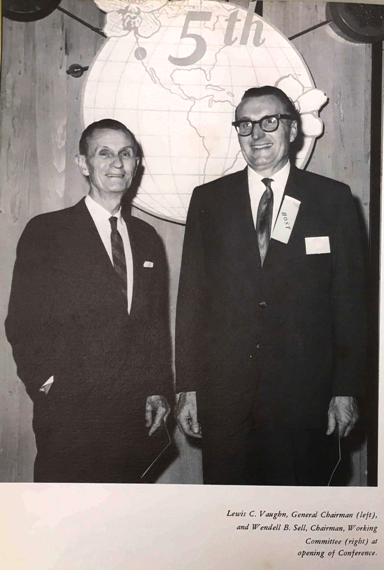
The big orchid party had its own beauty queen, Donna Ewing, of Long Beach. We're still looking for more information about her and about the party itself. So far as we know at this time, Donna was not an orchid grower, but she clearly enjoyed posing with an armload of the latest Cymbidiums. In those days, everyone dressed for orchid shows! It was a big occasion. It has to be said, too, that while the price of commercially available orchid seedlings was very reasonable, top quality plants were still only available as divisions. Cloning was in its infancy. Unless you knew someone who had a division to spare, acquiring an awarded plant could be an expensive proposition. Or, you could buy up seedlings from the latest crosses, baby them along for several years, and maybe end up with something amazing, as several of our members have done over the years.
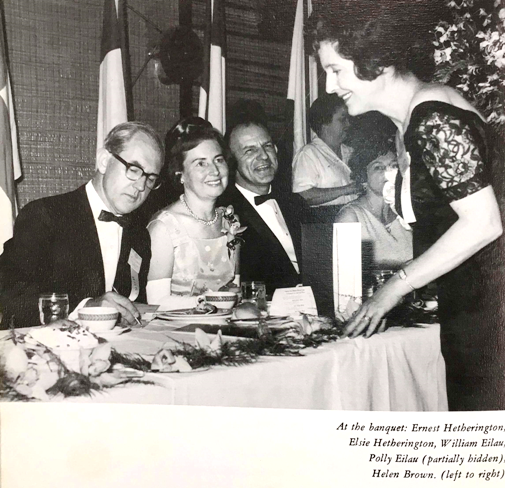
Certainly all the local growers were in attendance, famous names such as Ernest Hetheringon. Our friend Dr. Harold Koopowitz presented a paper in the lecture sessions, and we understand our long-time member Dr. Norito Hasegawa was inspired to start growing orchids himself after viewing the exhibits. We would very much like to hear from anyone else who was there! A copy of the official program ended up in the collections of The Huntingon. We hope to have a chance to copy it soon. Many of the local orchid hobbyists and growers helped with the logistics as well: Clark Day, Jr. and Jerry Rehfield led the transportation committee! Rita and Herbert Crothers handled plant registration. Ernest Hetherington was in charge of local publicity. Paul Gripp organized tours to the nurseries in Santa Barbara. Former SCOS President John Hanes served as the Vice Chairman for Judging. Mrs. Hanes worked on program planning and facilities (that would have included arrangements with the Long Beach Arena as well as the Lafayette Hotel). Charles Bowman, SCOS President in 1958, 1959, and again in 1969, was the liaison between the Conference organizing committee and local societies.
As time permits, we will copy the list of judges who were pressed into service for this event as well. A total of 127 plants received awards, the details of which were included in the Proceedings. The top award by far went to Andy Yamamoto of Culver City for Cymbidium Orchid Conference ‘Green Light’ (Cym. Sola × pumilum album), a staggering 91.32 points. Perhaps not surprisingly, given the season when the Conference was held, most of the awards were for Cymbidiums. There were no Paphiopedilums, because at that time they were still called Cypripedium in horticulture! The awards also included plants that had traveled great distances to participate in the exhibits, including Vandas from Singapore and Malaysia, and a selection from the Oncidium alliance exhibited by Vacherot & Lecoufle, from France.
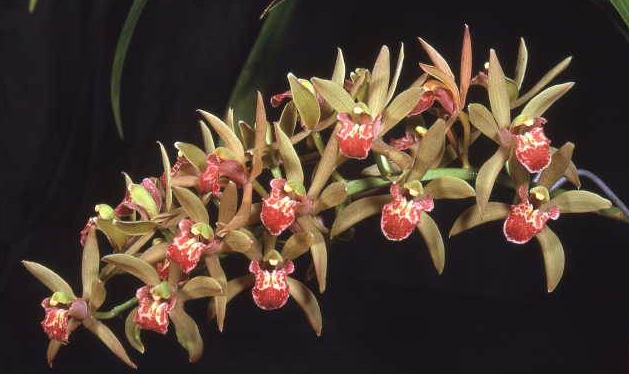
We are indebted to Ron McHatton of AOS for an explanation of how the World Orchid Conference awards work: These events don't actually use AOS judging standards, and there are normally judges from all over the world who volunteer or are invited to judge the exhibits, or to judge individual plants. However, there is no uniform set of standards used for World Orchid Conference judging, and therefore the awards, while clearly significant, can't be directly compared with those made under official AOS standards by AOS judges. Hence, we don't find the World Orchid Conference awards listed in the AOS awards database. Nevertheless, the flowers that caught the judges' eyes in 1966 were clearly some excellent plants! We have started searching for pictures of the awarded plants and will add our results here at a later date!
There was some interesting press coverage, too — Ernest Hetherington came through with a nice teaser in the Los Angeles Times on April 10, 1966, the Sunday before the Conference, under the headline "Orchids to See and to Grow".
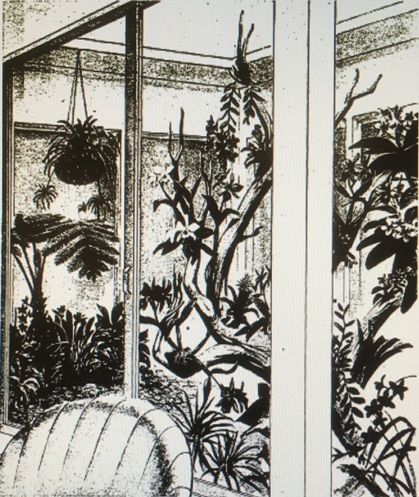
Orchids to See and to Grow
This atrium is both a proof and a reminder—proof that you can have a tropical garden in your home and a reminder to go to the show which starts Thursday at the Long Beach Arena in connection with the World Orchid Congress. Two things are essential if you want to grow orchids in your home: humidity and a soft light. These are provided here by complete enclosure, like the old-fashioned bell garden, and by a sunshade of translucent plastic. The result is more than just a huge plant container. There is an illusion of a fine garden vista from every room which look into the atrium.
We suggest that you go to the show in Long Beach because the Congress is a kind of orchid World Series. The show opens Thursday, April 14, and closes Sunday, April 17. Hours are 10 a.m. to 10 p.m. The Congress, at the Lafayette Hotel, meets from April 15 to 19. More than 2,000 growers from throughout the world are expected for the meetings. The show is sponsored by the Orchid Society of Southern California, The American Orchid Society and the Royal Horticultural Society of England. Cymbidiums will be featured prominently, but there will also be masses of the better-known cattleyas and displays of the so-called botanicals. And there will be demonstrations of the propagating technique, displays on diseases and pests, and exhibits of corsages and arrangements—everything you need to know to start this atrium. Also, watch for next Sunday’s issue of Home magazine which will carry a feature story in color on orchids. Produced by Dr. Robert E. Atkinson/Illustrated by William V. Brace.
A few days later, April 14, the Times ran a story featuring one of our long-time members, Mary Ann Barnett (we will have more about the Barnetts at a later date).
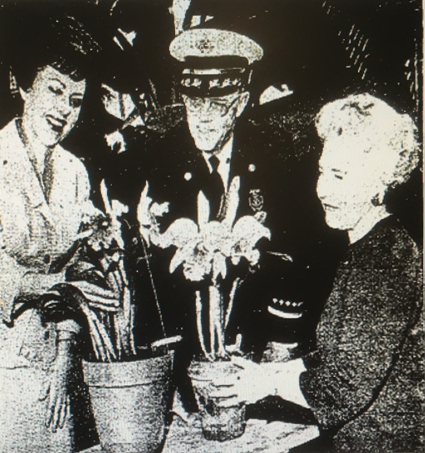
Pair Ready for Orchid Conference
Newport Beach – Members of the Orange County Orchid Society participating in the fifth World Orchid Conferens and Show at Long Beach Arena today through Sunday, Paril 17, will include Fire Chief Jan Briscoe of Newport Beach and Mrs. Briscoe.
Raising orchids in their two greenhouses is a hobby of Mr. and Mrs. Briscoe.
Mrs. Briscoe enjoys a wide reputation of having won many honors for her use of orchids in arrangements. She says that her chief love is arranging orchids in artistic designs for enjoyment in the home and for wearing as corsages.
White Cattleya
Mrs. Briscoe will be exhibiting arrangements at the Long Beach Show.
Another prominent orchid-growing couple is Mr. and Mrs. P. G. Barnett, also of Newport Beach. The Barnetts enjoy their private collection of 1,000 cattleyas, among which is the renowned white cattleya, the Mary Ann Barnett, named for Mrs. Barnett. It was bred at the B. O. Bracy Co. Orchid Range in Santa Ana.
A blooming Mary Ann Barnett plant will be featured in the Barnett display at the Long Beach show, together with an oil portrait in which the orchid appears.
Over $1 million worth of orchids will be on display at the World Orchid Show. International competition will be judges by a panel of 200 judges from throughout the world.
Society Display
Robert Green of Garden Grove, president of the Orange County Orchid Society, said the show affords “a once-in-a-lifetime opportunity to view such beauty in exotic settings.”
The Orange County Society will have a display at the show open to the public for a fee. The Orange County group has Sidney Lowery, Santa Ana, and Vince Scoggins, Huntington Beach, as vice presidents; Peg McBurney, Yorba Linda, secretary; Walter Belville, Buena Park, treasurer, and Mrs. Robert Potter, Huntington Beach, membership chairman.
The Orange County Society meets each third Monday at 7:30 p.m. at the Orange County Farm Bureau, 1913 Chapman Ave., Orange.
Finally, a long article with photographs of many orchids, presumably from the show, appeared on Sunday, April 17. As digitized in black and white, the photos are not suitable for display here, but we think they should still be in the photo archives of the Los Angeles Times, and we can probably find other pictures of the same varieties. We will add them here if and when we find them, but for now, we will replace them with newer pictures of the same plants! The article touches on many aspects of orchid history in Southern California, to which we hope we can return later. Here it is, errors and all, with our added footnotes:
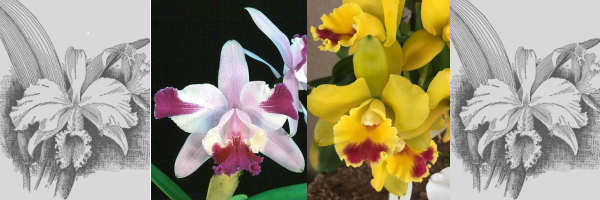
Orchids: the reward is worth the effort
By Dr. Robert E. Atkinson. The World Orchid Congress1 and Show now being held at the Long Beach Arena—it closes today at 6 p.m.—has focused attention once more on the question: Are orchids practical for the average home gardener? The answer to that depends on what kind of orchid you have in mind. Cypripediums2 are as easy to grow as African violets and need about the same care. Cymbidiums can be grown out of doors in the milder parts of our area. Cattleyas, however, require an atrium or greenhouse where humidity can be provided on hot, desert-dry days. The photograph above3 shows a group of the latter, which are, reading from the left, Laeliocattleya Jim Frazer, Cattleya intermediatee Aquinii; Laeliocattleya Lemon Drop, a miniature, and L.c. Gypsy Dance.
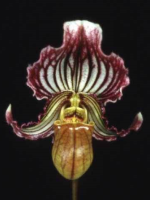
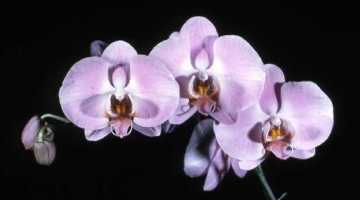
Generally accepted as the easiest to grow of all of orchids is the Lady Slipper, usually called “cyp,” short for Cypripedium. However, these much-hybridized natives of Assam are classified as Paphiopedilum. They are distant relatives of our native lady slipper or moccasin flower. “Cyps” are having a renaissance and the trend is away from the speckled types toward the lighter yellow-green and the red or mulberry colors. P. fairrieanum is a dwarf species, while Golden Acres is one of the newest varieties. Orchid growers like “cyps” because they bloom before cymbidiums and when most cattleyas have faced, but their popularity is due chiefly to their freedom from pests and diseases, their adaptability to varied conditions of light, temperature and humidity, and to their compactness, free-blooming habits and long-lasting flowers.
Cymbidiums come from the Himalayas where they grow about 5,000 to 7,000 feet. At these elevations near the equator the sunlight is intense, and the nights are cool and the days are mild. No wonder they thrive outdoors in California! The miniatures are even more adaptable and, unlike the standard cymbidiums, do not require cold fall nights to bloom. All they need is half shade, plenty of water and mild fertilizer. Pumander, the Imp4 developed in 1944, was one of the first miniatures. Korintji and Pipeta (1962) have the added attraction of fragrance.
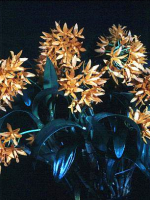

Brassia verrucosa is one of the best known of the “spider” orchids. It is popular with all collectors because of its fragrance and the ease with which it is brought into bloom. It is a native of Mexico and must be kept under the same conditions as a cattleya.
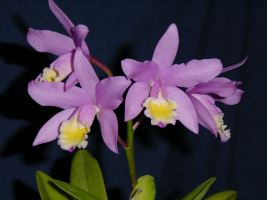
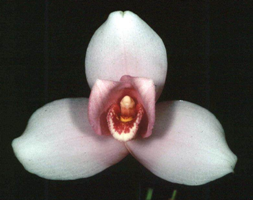
The miniature Cattleya loddiaca is one of the bifoliates with heads of delicate flowers which are 2 ½ to 3 inches across. It was derived from a cross between Cattleya loddigesii with white flowers and C. aurantiaca5 with bright orange flowers. Yellows were expected from this combination but most are pink.
Southern California breeders have led the orchid world in such advances as cymbidium breeding, the development of miniatures, and the white bifoliate cattleyas. They are at the forefront in the latest craze for red orchids and showed the way in the early development of yellow, bronze and purple cattleyas.
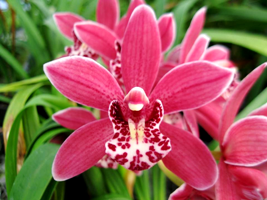
Back in 1922 the variety Alexandria Westenbirt6 turned up in the nursery of A. G. Alexander in Tetbury, England, and great things have been happening ever since to cymbidiums, mostly in Southern California. It produced such hybrids as Jungfrau and Rosanna Pinkie, latter the envy of every hybridist the world over. It first bloomed at Exbury, the Rothchild’s English estate, and was acquired by Dos Pueblos Orchid Co. of Goleta in 1953. Progeny of this sire include Balkis, Nam Khan and many others. Offspring of Balkis include the sterile triploid, Lillian Stewart, the world’s most highly honored orchid of all time.7 Other tetraploid stud plants, Babylon and Pauwelsii, have been used by cymbidium breeders to create highly awarded progeny. In the development of miniature cymbidiums, the leaders have been Fred Stewart, Mrs. Emma D. Menninger, Dr. Lee Lenz, Mary Bea Ireland, and the late Arno Bowers and many others, all of Southern California. Miniature cattleyas, on the other hand, have been promted chifely through the interest of Ernest Hetherington ot Stewart’s Orchids.

Armacost and Royston of West Los Angeles took a lead in breeding cattleyas. Before World War II, B. O. Bracey was in charge of the breeding program and trained many of the men who became famous for their crosses, including Oscar Kirsch and William Kirsch of Honolulu, Hetherington, Joe Ozella of Hawthorne and Joe Hampton of Dos Pueblos.
In 1952 Ben Bracey formed his own company and developed L.c. Bonanza, one of the greatest orchids of all time. Ozella developed L.c. Lee Langford and other yellow and bronze varieties before he died in 1957. Joe Urmston, who died the same year, is best known for his work on the effect of length of day on flowering. He developed the methods of blooming cattleyas under lights used in commercial flower production.
Recently the white bifoliates, called “wedding whites” have been extremely popular with florists. The while exhibition cattleyas, derived from Bowbells and Bob Betts, outstanding parents of choice flowers, also came into prominence. The “semi-albas,” white cattleyas with a purple or red lip, have received renewed interest with Leo Holquin of Armacost and Royston showing the say. The search for red cattleyas started by Ozella has engaged the talents of such orchidists as Philip Ilsley of Beverly Hills and Frank Fordyce of Carlsbad, as well as Hetherington. No crosses have excited orchid growers everywhere as much as the red Sophronitis and Potinara hybrids and the offspring of bronze and dark red-lavender cattleyas. Red strans issue from parents with no red in their ancestry and geneticists are busy explaining this inexplicable phenomenon.
1.The event was officially a World Orchid Conference, perhaps to distinguish it from the series of Western Orchid Congresses.
2.In 1966, the plants classified by botanists as Paphiopedilum were still called Cypripedium by the American Orchid Society, the Royal Horticultural Society, and most growers.
3.So far, we don't have a photograph of all of these plants. Lc. Jim Frazer is now known as C. Jim Frazer (C. Labi-Royal × Joseph Hampton), no picture has been found. C. intermedia aquinii is a well-known splash-petal variety. Lc. Lemon Drop is now a Cattlianthe due to recent changes in taxonomy. Lc. Gypsy Dance is not registered, but it is possible this was an error for (now Cattleya) Gypsy Queen, then a newly-registered hybrid by B. O. Bracey, C. Bonanza × C. percivaliana, for which we could find no picture.
4.That is, Cymbidium Pumander 'The Imp'.
5.Cattleya aurantiaca is now classified as Guarianthe aurantiaca, and the hybrid with C. loddigesii is therefore now known as Cattlianthe Loddiaca.
6.The plant is correctly called Cymbidium Alexanderi 'Westonbirt'.
7.Was Cymbidium Lillian Stewart then the most highly awarded orchid? Within the realm of the AOS, possibly it was, but we strongly suspect it might have been surpassed even then by some of the progeny of Alexanderi 'Westonbirt', or perhaps by some of the Paphiopedilum species. Today, there are certainly many hybrids and species with more awards than Lillian Stewart, but we don't know which one holds the record. Perhaps we should ask the Guinness organization to investigate this question.
